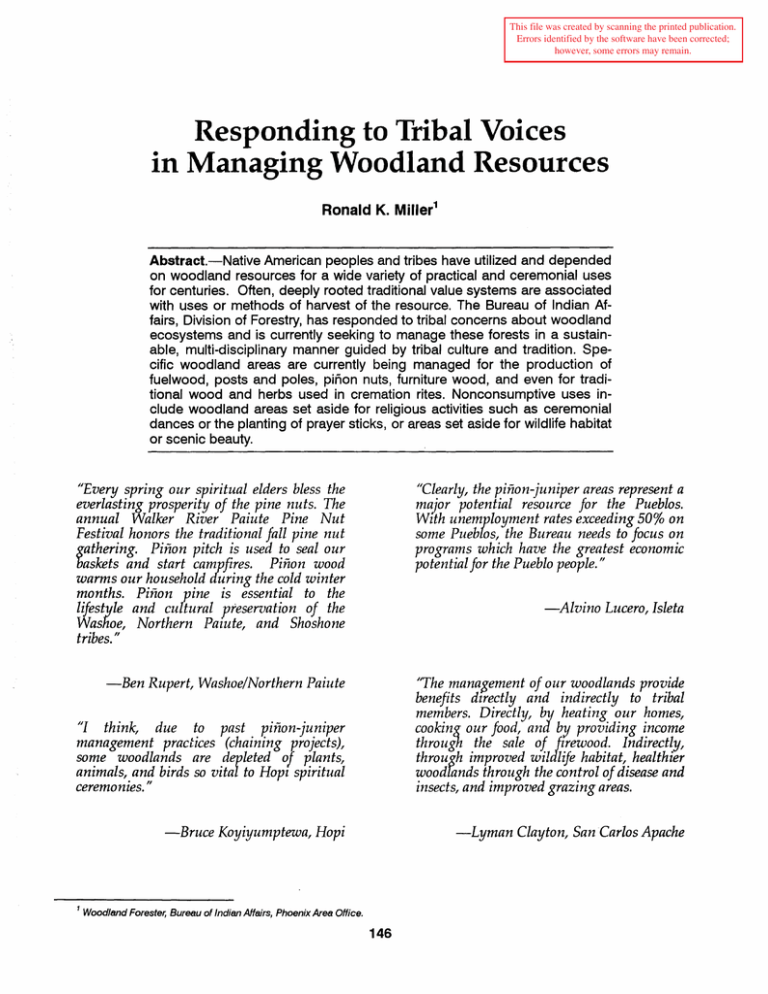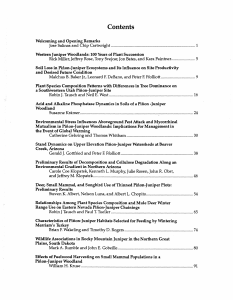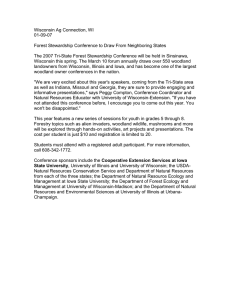Document 11863758
advertisement

This file was created by scanning the printed publication. Errors identified by the software have been corrected; however, some errors may remain. Responding to Tribal Voices in Managing Woodland Resources Ronald K. Miller1 Abstract.-Native American peoples and tribes have utilized and depended on woodland resources for a wide variety of practical and ceremonial uses for centuries. Often, deeply rooted traditional value systems are associated with uses or methods of harvest of the resource. The Bureau of Indian Affairs, Division of Forestry, has responded to tribal concerns about woodland ecosystems and is currently seeking to manage these forests in a sustainable, multi-disciplinary manner guided by tribal culture and tradition. Specific woodland areas are currently being managed for the production of fuelwood, posts and poles, pinon nuts, furniture wood, and even for traditional wood and herbs used in cremation rites. Nonconsumptive uses include woodland areas set aside for religious activities such as ceremonial dances or the planting of prayer sticks, or areas set aside for wildlife habitat or scenic beauty. HEvery spring our spiritual elders bless the everlasting prosperity of the pine nuts. The annual Walker River Paiute Pine Nut Festival honors the traditional fall pine nut gathering. Pinon pitch is used to seal our baskets and start campfires. Pinon wood warms our household during the cold winter months. Pinon pine is essential to the lifestyle and cultural preservation of the Washoe, Northern Palute, and Shoshone tribes. " HClearly, the pinon-juniper areas represent a major potential resource for the Pueblos. Wlth unemployment rates exceeding 50% on some Pueblos, the Bureau needs to focus on programs which have the greatest economic potential for the Pueblo people. " -Ben Rupert, Washoe/Northern Paiute HI think, due to past pinon-juniper management practices (chaining projects), some woodlands are depleted of plants, animals, and birds so vital to Hopl spiritual ceremonies. " fThe management of our woodlands provide benefits dlrectly and indirectly to tribal members. Directly, by heating our homes, cooking our food, and by providing income througn the sale of flrewood. Indirectly, through improved wildlife habitat, healthier woodlands through the control of disease and insects, and improved grazing areas. -Bruce Koyiyumptewa, Hopi -Lyman Clayton, San Carlos Apache 1 -Alvino Lucero, Isleta Woodland Forester, Bureau of Indian Affairs, Phoenix Area Office. 146 INTRODUCTION PAST WOODLAND MANAGEMENT Native American peoples and tribes have utilized and depended on woodland resources for a wide variety of practical and ceremonial uses for centuries. More importantly, perhaps, most Southwestern tribes have lived in the pmon-juniper ecosystem for centuries. Given that long-term association, the connections between tribes and the resource are often very strong, with deeply rooted traditional value systems associated with uses or methods of harvest of the resource. A natural resource professional working with a tribe must understand the cultural connections to the resource just as he or she must understand the silvics and ecology of the woodland species being managed. One must also understand that tribal cultures differ and what is acceptable to one tribe is not necessarily acceptable to another tribe. The quotes prefacing this paper are from members of four different Southwestern tribes. They touch on the importance of the pmon-juniper ecosystem to tribal people whether that value relates to cultural, spiritual, economic, aesthetic, medicinal, or subsistence issues. Most likely, the relationship with the resource is a combination of all of the above. Often the resource and the culture are so intertwined that the various components cannot be separated. Indeed, the Native American world view tends to look at things holistically, rather than as individual components. Tribal relationships with pmon-juniper resources have existed for centuries and current literature and ethnobotanica1. studies expound on these age-old ties (Ackerly 1991, Koyiyumptewa 1993, Miller and Albert 1993, Watahomigie et al. 1982). The Hualapai have even published a beautiful, full-color, 20-page booklet in their own language that discusses their relationship with pmon (Watahomigie et al. 1983). The booklet is entitled Ko, the Hualapai name for pmon. The importance of pmon-juniper woodlands is magnified by their sheer abundance in the Southwest. Arizona's woodland area of 14.3 million acres, for instance, is more than 2-1/2 times that of timberlands (Conner et al. 1990), while Nevada's woodland (9 million acres) represents almost 12 times that of Nevada's timberlands (Born et al. 1992). Here in Arizona, Indian tribes own 35% of the woodland, making tribes the largest woodland ownership class in the state. Current estimates of Indian-owned woodland in Arizona range from 5.0 million acres (Conner et al. 1990) to 5.6 million acres (Bureau of Indian Affairs 1988). ' Although the resource is so large, the potential so great, and the cultural ties so deep, integrated management and full consideration of pmonjuniper woodlands is still in its infancy. In the past, woodlands were either ignored, or worse, a war was waged against them in the form of chaining, cabling, pushing, burning, tree crushing, grubbing, chopping, and herbiciding. Any2 thing, to get rid of those short, scrubby trees. In Arizona alone, nearly one million acres of pmonjuniper woodland were cleared between 1950 and 1959 (Arnold et al. 1964). Another 300,000 acres were cleared between 1960 and 1985 just on Forest Service lands in Arizona and New Mexico (Dalen and Snyder 1987). The Bureau of Land Management (BLM) was busy as well, chaining half a million acres of pmon-juniper in the West between 1960 and 1972, 61,000 acres of which were in Arizona (Aro 1975). As stated by former Forest Service Southwest Regional Forester, William Hurst (1977), "Perhaps no vegetative type (P-J) has given man so much and been so harshly treated and neglected." The Bureau of Indian Affairs (BIA) was not immune to the management strategies of the day. In some places the techniques were different but the intent was the same. On the Hualapai Indian Reservation in northwest Arizona, nearly 22,000 acres of pinon-juniper were burned between 1953 and 1963 for conversion purposes (Despain 1987). Meanwhile, on the Fort Apache Reservation, tribal members were kept busy with hand axes clearing 95,000 acres of pmon-juniper by 1958 (Arnold et al. 1964). Chaining also occurred on many southwestern Indian reservations. This is especially ironic since pmon-juniper woodlands contain such an abundance of archaeological sites, and chaining proved so destructive to these valuable, nonrenewable resources (DeBloois et al. 1975). Irreplaceable tribal history and culture were destroyed in the name of range improvement. McNichols (1987) traced the evolution of p-J management on the Hualapai Reservation from no management, to an emphasis on removal or eradication, and finally to a strategy of multiple use and sustained yield. It took an active intervention by tribes themselves, however, to generate the support necessary to establish a national woodlands program. 2The reason given for all this activity was, of course, "range improvement". However, many of the clearing projects, along with the reasons given for them, are seriously questioned by such notable authorities as Dr. Ronald Lanner and Dr. Elbert Little among others (Lanner 1981, 1993; Little 1991, 1993). 147 under the direction of the Bureau's Forestry Program, as the dominant woodland values are relative to the culturing and utilization of true tree species, and as co-management principles, as well as multiple-use practices, are currently stressed nationwide by the program. BACKGROUND On April 15, 1987, Alvino Lucero, Vice President of the Isleta Pueblo Tribal Council, testified before the Bureau of Indian Affairs Agriculture - Range Programs Committee. He presented a strong case detailing the importance of the pinon-juniper woodland resource to the Pueblo people. Primarily focusing on the economic potential of the resource, he stated: You shall therefore adjust your programs accordingly and insure that all future resource management plans and plan revisions incluae the addition of woodland management responsibilities to the Forestry Program. Arrangements should be 1nade to provide assistance and oversight on these wooded reservations to meet the needs of the Indian owners. " HMost of our forests in tenns of acreage and wood volumes consist of piflOn-juniper trees as opposed to comnlerczal species such as ponderosa pine. For example, the four Pueblos of Aconza, Isleta, Jemez and Zia have an annual allowable cut of ponderosa pine of about 2 million board feet. This represents combined potential revenues of $20,000 per year. In contrast, these same Pueblos could harvest approxiJnately 1,560 cords of piFzonjuniper per year. Based on $100 per cord, this would bring in gross revenues of $156,000 each year. Clearly, the PiFzonJuniper areas represent a major potential resource for the Pueblos. With unemployment rates exceeding 50% on some Pueblos, the Bureau needs to focus on progranls which have the greatest economic potential for the Pueblo people. ,,3 Several key points stand out in this directive. First, there was a recognition of tribal interest in woodland management. Second, woodland management was moved under the direction of the forestry progranl where the value of trees was more likely to be recognized and the resource managed in a multi-disiplinary manner. Third, the resource was to be actively managed and considered in forest planning activities, rather than ignored as had often happened in the past. Finally, the focus of this planning and management was to nleet the needs of the Indian owners. Recognizing that tribal goals and objectives for their woodland resources vary across the country, the Assistant Secretary provided latitude to respond to tribal direction in the management and oversight of woodland resources. This directive now guides woodland management on Indian reservations throughout the United States. A few years later (1990), Public Law 101-630, the National Indian Forest Resources Management Act, became law. This legislation further cenlented woodland's status by mandating proper planning and luanagement of all Indian forest land. "Indian Forest Land" was specifically defined in the law to include both woodlands and tinlberlands. The following month, the Southern Pueblos Governors Council wrote a letter to the Assistant Secretary - Indian Affairs ~n behalf of the nine Southern Pueblos in New Mexico. The Assistant Secretary was asked to expand the BIA's focus and work to include management of woodland resources. Within three months, on August 10, 1987, a directive was sent fronl the Assistant Secretary to all Area Offices. The policy direction was clearly stated: HRecent shifts in the economy have stimulated considerable interest by tribal leaders in the developnlent of their woodland resources. This is primarily the result of opportunities which now exist for the sustained harvest of marketable jorest products, particularly those associate with the Pinyon-Juniper woodlands of the west. Management of this resource is best provided WOODLAND FUNDING AND RECOGNITION Congress appropriated the first woodland program dollars ($500,000) to the BIA in fiscal year 1990, thanks in large part to continued lobbying efforts by the Intertribal Timber Council and individual Indian people. It is interesting to note that in 1990 the Director of the BLM signed an initiative called "Forests: Our 3Timber prices in the Southwest have greatly in~reased since this testimony was given. Nonetheless, the Pueblo's point about the need to focus on their predominant resource remains valid. 148 any cord wood for resale to outside markets. The point is, tribes are given the latitude to customize woodland projects to fit local needs, desires, and traditions. Nonconsumptive uses of woodland areas are just as important to tribes as consumptive uses. Nonconsumptive uses include areas set aside for religious activities such as ceremonial dances (Utes) or planting prayer feathers (Zunis), or woodland areas set aside for wildlife habitat (Apaches) or scenic beauty (Navajos). The widespread practice of gathering pmon nuts-nonconsumptive, at least as far as the tree is concerned-also fits into this category. The vast majority of Southwestern tribes depend on pmon nut harvesting for traditional food or economic purposes. Although tribal members from many tribes do not sell pmon nuts as a matter of principle, Tanner and Grieser (1993) estimate that over 90% of the commercial pmon nut crop is harvested by Native Americans-a crop estimated by Evans (1988) to be 1-2 million pounds of nuts per year. Due to cultural and tribal differences, woodland project proposals requiring BIA funding must contain a signed tribal resolution to ensure tribal support and involvement. Proposals springing from the tribes have a much greater chance of success and allow diversity in management approaches. Value-added processes or those that provide tribal employment are also looked at favorably when determining which projects should receive funding. The Zuni Furniture Enterprise is a perfect example of a tribal business that utilizes woodland resources and produces beautiful, value-added products while providing tribal income and employment. The considerable artistic talents of the Zunis playa major part in making the furniture enterprise a success. Four examples of diverse tribal approaches to woodland management and use from within the jurisdiction of the BIA's Phoenix Area Office follow. Growing Legacy," giving woodland under their jurisdiction the same s ta tus and policy guidance as other forest land; and in 1992, Region 3 of the Forest Service issued their Pinon-Juniper Initiative, also bringing woodland management into the limelight. Larry Henson (1993), the Southwest Regional Forester at the time, later publicly stated that the Forest Service "must improve pmonjuniper woodland management in the Southwest while recognizing the inherent values, including cultural values, of the pmon-juniper ecosystem." It is encouraging that the major land managing agencies are recognizing woodland's importance and are moving toward proper management of the same. It is also interesting to note that Mr. Henson pointed out the cultural connection inherent with woodlands. MANAGING WOODLANDS TO MEET TRIBAL NEEDS AND DESIRES Woodland ecosystems, given their long association with people, need to be managed considering the human component rather than considering man as an outside force. Archaeologists Cartledge and Propper (1993) state that in order to understand pinon-juniper ecosystems today, it is crucial to understand what those ecosystems were like in the past and what forces, including human beings, affected them. They continue, "Pinon-juniper woodlands did not exist in a pristine unaltered condition prior to the arrival of Europeans. Human beings have made extensive, and in some cases intensive, use of pinon-juniper woodland resources for thousands of years." Given that use, the key is to manage the woodland ecosystem in an integrated manner so that the resource is sustained even while it provides for the people dependent on that ecosystem. Even though the BIA's constituency (tribes and tribal members) is much more well defined than the Forest Service or the BLM constituencies, tribes also respoTI'd differently with requests for woodland funding and assistance. For example, the White Mountain Apaches have used woodland funding to open a wood yard on their reservation, but are reluctant to cut green pinon or juniper. Instead, dry Gambel oak (Quercus gambelll) currently makes up most of the fuelwood volume. On the other hand, their neighbors to the south, the San Carlos Apaches, recently harvested 840 cords of green alligator juniper Uuniperus deppeana) for sale through their tribal wood 'yard. Other Southwestern tribes are not interested in cutting Hopi Reservation - Arizona Integrated Woodland Management Plan The Bureau of Indian Affairs is currently working with the Hopi Tribe to develop a comprehensive, integrated woodland management plan for the tribe's 197,028 acres of pmon-juniper woodland. One of the first steps in the planning process involved a two-page questionnaire designed to poll tribal members about their priorities for tribal woodland areas. The questionnaire was 149 tural manipulation of the stands. Local site data gathered on this project will be useful in future decisions guiding proper management of the woodland resource. hand-carried to all of the Hopi villages by tribal members to encourage maximum participation. Responses from 226 households were gathered. Tribal members were asked about their personal uses of the woodland areas, and what they thought the Tribe's management objectives for different woodland areas should be. Respondents indicated that the top three management priorities for woodland areas should be for fuelwood production, culturaVreligious needs, and water production. There is a strong desire to protect the woodland resource, but an equally strong desire not to infringe on tribal members' rights to utilize the woodland resources for ceremonial and subsistence purposes. "Religion cannot be regulated" was often heard during scoping sessions. The management plan will try to synthesize necessary human use requirements into an integrated management scheme that fully considers wildlife, watershed and soil protection, aesthetics, recreation, and range concerns. Washoe Pine Nut Allotments - Nevada Pilion Nut Production The Pine Nut Allotments in western Nevada's Pine Nut Mountains were reserved specifically for the Washoe people under the authority of the 1887 Dawes Act. Currently, there are over 66,000 acres in individual 160-acre parcels that belong to specific Indian owners rather than to a tribal entity. The allotments contain stands of singleleaf pifton (Pinus monophylla) with a smaller component of Utah juniper Uuniperus osteosperma). Problems associated with the stands include trespass cutting of live trees, a minor outbreak of Ips bark beetles (Ips confusus) and some dwarf mistletoe (Aeuthobium dwaricatum). This area provides a perfect opportunity to use good silviculture to protect the health and vigor of a resource that is culturally important. Treatments are planned which are designed to increase nut prod uction and the vigor of the residual stand while reducing the incidence of dwarf mistletoe. Harvesting must be timed in late fall or early winter so as not to increase the potential for a large Ips outbreak. Allottees provide the specific goals and objectives or desired future condition for their allotment, while resource professionals help them achieve those goals through sound forest practices. Uintah and Ouray (U&O) Ute Reservation Utah Woodland Demonstration Blocks Six 2.5-acre woodland demonstration blocks were set up this year within a Pinus edulis/Artemisia tridentata (PIED/ARTR) habitat type on the U&O Ute Reservation. Tree species present in the blocks are Colorado pinon (Pinus edulis) and Utah juniper Uuniperus osteosperma). The blocks demonstrate different silvicultural prescriptions such as shelterwood, group selection, a pifton nut orchard and a control block. Two other blocks show individual tree selection prescriptions with residual basal areas of 40 and 70 square feet per acre, respectively. Fuelwood and fenceposts generated by the project will be transported to the tribal wood yard, processed, and sold. Slash will be lopped and scattered to control erosion and to provide favorably microsite conditions for grass, forbs and seedling regenera tion. The entire area is to be fenced and sigried after harvest. Plans also call for two additional blocks to be surveyed outside the fence. One of the blocks outside the fence will be a second control block to monitor any changes the fence itself causes, and one block will be installed in an adjacent area that burned in 1989. Installation of range and wildlife transects is included in the monitoring efforts. The blocks will provide a visual demonstration to the Tribal Council and tribal members and allow for local monitoring of changes resulting from silvicul- Colorado River Indian Reservation Arizona and California Woodland Inventory to Guarantee Sustainability of Cultural Resource The Colorado River Indian Reservation encompasses 269,921 acres in Arizona and California bisected by the Colorado River. Tribal membership includes 3,057 people. This reservation is outside the range of pifton-juniper, but contains honey mesquite (Prosopis glandulosa) woodland. Many of the original stands of mesquite on the Reservation became depleted due to overharvesting, changes in groundwater and flooding, and conversion of natural vegetation to farmland. The Colorado River Indian Tribe became concerned that the resource might not be able to meet traditional cultural needs and, therefore, placed a six month moratorium on mesquite wood cutting and land conversion. The cultural need, in this 150 particular case, was for the use of mesquite logs and arrowweed (Tessaria sericea) .in funeral pyres for traditional Mohave cremations. Log lengths, diameters, and volume requirements of the mesquite are specific depending on whether the deceased member was an adult or a child. Given guidelines laid out by the Tribe, the University of Arizona's Office of Arid Lands Studies conducted a woodland inventory and issued a final report (Nabhan et al. 1985). Researchers had to match tribal death rates by size of the individual with woodland volume, growth data, and size of the trees. Although the subject is not a pleasant one to contemplate, the study was essential to Mohave tribal members who justifiably maintain that they must be guaranteed sufficient, sustainable quantities of mesquite and arrowweed for their funeral rites. As a result of the study, two large areas containing sufficient mesquite to meet the Mohave's future needs have been reserved along the banks of the Colorado River. who spent time giving me personal insights into their tribal culture and beliefs. Appreciation is also extended to Lucille Watahomigie of Hualapai who sent me two of her beautifully done books: Ethnobotany of the Hualapai and Ko (pmon). LITERATURE CITED Ackerly, Neal. 1991. Ethnobotany. In: Proceedings-1991 Pinon Conference. 1991 April 23; Santa Fe, NM. New Mexico State University, College of Agriculture and Home Economics. Las Cruces, NM: 59-62. Arnold, Joseph H; Jameson, Donald A.; Reid, Elbert H. 1964. The pinyon-juniper type of Arizona: Effects of grazing, fire, and tree control. Prod. Res. Report No. 84. Fert Collins, CO: U.S. Department of Agriculture, Forest Service, Rocky Mountain Forest and Range Experiment Station: 28 p. Aro, Richard S. 1975. Pinyon-juniper woodland manipulation with mechanical methods. In: The pinyonjuniper ecosystem: A symposium; 1975 May; Logan, UT: Utah State University, College of Natural Resources. Logan, UT: 67-73. Born, J. David; Tymcio, Ronald P.; Casey, Osborne E. 1992. Nevada forest resources. Res. Bull. INT-76. Ogden,· UT: U.S. Department of Agriculture, Forest Service, Intermountain Research Station. 64 p. Bureau of Indian Affairs. 1988. Native American woodland resources: A national overview, Assessing the resource potential and management needs. U.S. Department of Interior, Bureau of Indian Affairs, Branch of Forest Resources Planning. Portland, OR: 139 p. Cartledge, Thomas R.; Propper, Judith G. 1993. Pmonjuniper ecosystems through time: Information and insights from the past. In: Aldon, Earl H and Douglas W. Shaw, technical coordinators. ProceedingsManaging pinon-juniper ecosystems for sustainability and social needs; 1993 April 26-30; Santa Fe, NM. Gen. Tech. Rep. RM-236. Fort Collins, CO: U.S. Department of Agriculture, Forest Service, Rocky Mt. Forest and Range Experiment Station: 63-71. Conner, Roger C.; Born, J. David; Green, Alan w.; O'Brien, Renee A. 1990. Forest resources of Arizona. Res. Bull. INT-69. Ogden, UT: U.S. Department of Agriculture, Forest Service, Intermountain Research Station. 92 p. Dalen, Raymond S.; Snyder, William R. 1987. Economic and social aspects of pinyon-juniper treatmentThen and now: In: Everett, R.L., compiler. Proceedings-Pinyon-Juniper conference; 1986 January 1316; Reno, NV. Gen. Tech, Rep. INT-215. Ogden, UT: U.S. Department of Agriculture, Forest Service, Intermountain Research Station: 343-350. DeBloois, Evan 1.; Green, Dee Hi Wylie, Henry G. 1975. A test of the impact of pinyon-juniper chaining on archaeological sites. In: The pinyon-juniper ecosystem: CONCLUSION Hopi's integrated woodland management plan, the Ute's woodland study blocks, stand improvements designed to increase the Washoe's pinon nut crop, and the study to ensure a sustainable supply of mesquite for the Mohaves provide examples of managing woodlands to meet tribal needs and desires. The BIA's woodland program sprang directly from tribal concern and involvement. Tribes requested that woodlands be fully considered and properly managed rather than ignored or eradicated as often happened in the past. Tribes prefer a holistic approach to woodland management, taking into account the human element and cultural and spiritual requirements. However, tribes are also unique, with their own histories, languages, cultures, and religious beliefs. The BIA does not try to standardize woodland programs. Instead, diversity and unique tribal approaches within the guidelines of sound forestry practices are encouraged. ACKNOWLEDGEMENTS The author wishes to acknowledge the people of the Pueblo of Zuni. Living and working for four years with the Tribe was instrument~l in shaping my own appreciation for the pmon-juniper woodlands of the Southwest. Special thanks to the folks 151 A symposium. 1975 May; Logan, UT: Utah State University, College of Natural Resources. Logan, UT: 153160. Despain, Del W. 1987. History and results of prescribed burning of pinyon-juniper woodland on the Hualapai Indian reservation in Arizona. In: Everett, R.L., com piler. Proceedings-Pinyon -Juniper conference; 1986 January 13-16; Reno, NY. Gen. Tech, Rep. INT215. Ogden, UT: U.S. Department of Agriculture, Forest Service, Intermountain Research Station: 145-151. Evans, Raymond A. 1988. Management of pifton-juniper woodlands. Gen. Tech. Rep. INT-249. Ogden, UT: U.S. Department of Agriculture, Forest Service, Intermountain Research Station: 34 p. Henson, Larry. 1993. The Forest Service's pifton-juniper initiative for the Southwest. In: Aldon, Earl E and Douglas W. Shaw, technical coordinators. Proceedings-Managing pifton-juniper ecosystems for sustainability and social needs; 1993 April 26-30; Santa Fe, NM. Gen. Tech. Rep. RM-236. Fort Collins, CO: U.S. Department of Agriculture, Forest Service, Rocky Mountain Forest and Range Experiment Station: 23. Hurst, William D. 1977. Managing pinyon-juniper for multiple benefits. In: Ecology, Uses, and Management of Pinyon-Juniper Woodlands. 1977 March 24-25; Albuquerque, NM. Gen. Tech. Rep. RM-39. Fort Collins, CO: U.S. Department of Agriculture, Forest Service, Rocky Mountain Forest and Range Experiment Station: 45-47. Koyiyumptewa, Bruce K. 1993. Spiritual values of the pifton-juniper woodland: A Hopi perspective. In: Aldon, Earl E and Douglas W. Shaw, technical coordina tors. Proceedings-Mana ging pifton -juniper ecosystems for sustainability and social needs. 1993 April 26-30; Santa Fe, NM. Gen. Tech. Rep. RM-236. Fort Collins, CO: U.S. Department of Agriculture, Forest Service, Rocky Mountain Forest and Range Experiment Station: 19-20. Lanner, Ronald M. 1981. The pifton pine: A natural and cultural history. University of Nevada Press: Reno, NV: 208 p. Lanner, Ronald M. 1993. What kind of woodland does the future hold? In: Aldon, Earl E and Douglas W. Shaw, technical coordinators. ProceedingsManaging pifton-juniper ecosystems for sustainability and social needs. 1993 April 26-30; Santa Fe, NM. Gen. Tech. Rep. RM-236. Fort Collins, CO: U.S. Department of Agriculture, Forest Service, Rocky Mountain Forest and Range Experiment Station: 14-18. Little, Elbert L. Jr. 1991. Pifton (Pinus edulis): An overview. In: Proceedings-1991 Pifton Conference. 1991 April 23; Santa Fe, NM. New Mexico State University, College of Agriculture and Home Economics. Las Cruces,NM: 72-76. Little, Elbert L. Jr. 1993. Managing southwestern pifionjuniper woodlands: The past half century and the future.In: Aldon, Earl E and Douglas W. Shaw, technical coordinators. Proceedings-Managing pifton-juniper ecosystems for sustainability and social needs. 1993 April 26-30; Santa Fe, NM. Gen. Tech. Rep. RM-236. Fort Collins, CO: U.S. Department of Agriculture, Forest Service, Rocky Mountain Forest and Range Experiment Station: 105-107. McNichols, Robert R. 1987. Management strategies in pinyon-juniper on the Hualapai Indian Reservation. In: Everett, R.L., compiler. Proceedings-PinyonJuniper conference; 1986 January 13-16; Reno, NY. Gen. Tech, Rep. INT-215. Ogden, UT: U.S. Department of Agriculture, Forest Service, Intermountain Research Station: 161-164. Miller, Ronald K.; Albert, Steven K. 1993. Zuni cultural relationships to pifton-juniper woodlands. In: Aldon, Earl E and Douglas W. Shaw, technical coordinators. Proceedings-Managing pifton-juniper ecosystems for sustainability and social needs; 1993 April 26-30; Santa Fe, NM. Gen. Tech. Rep. RM-236. Fort Collins, CO: U.S. Department of Agriculture, Forest Service, Rocky Mountain Forest and Range Experiment Station: 74-78. Nabhan, Gary P.; Warren, Peter L.; Parton, Michael. 1986. Mesquite resources of the Colorado River Indian Tribes Reservation. University of Arizona, College of Agriculture, Office of Arid Lands Studies. Tucson, AZ. Tanner, Ellis; Grieser, Don. 1993. Four generations trading pifton nuts with Native Americans: Changes needed for future prosperity. In: Aldon, Earl E and Douglas W. Shaw, technical coordinators. Proceedings-Managing pifton-juniper ecosystems for sustainability and social needs; 1993 April 26-30; Santa Fe, NM. Gen. Tech. Rep. RM-236. Fort Collins, CO: U.S. Department of Agriculture, Forest Service, Rocky Mountain Forest and Range Experiment Station: 2933. Watahomigie, Lucille J.; Po wskey, Malinda; Bender, Jorigine. 1982. Ethnobotany of the Hualapai. Hualapai Bilingual Program, Peach Springs School District No.8. Peach Springs, AZ. Watahomigie, Lucille J.; Watahomigie, Philbert Sr.; Powskey, Malinda; Bender, Jorigine; Uqualla, Josie. 1983. Ko. Hualapai Bilingual Program, Peach Springs School District No.8. Peach Springs, AZ. 152







